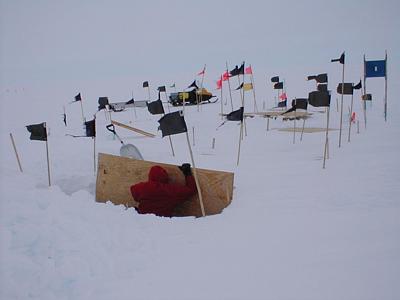26 November, 2000
Ice Holes
Gary Clow and Bob Hawley continue the process of logging the temperature of
the main drill hole. They did a convection test yesterday. The hole is
filled with drilling fluid, it has a large diameter, and the temperature is
higher at the bottom. These conditions result in convection currents. For
the test, the probe is parked at one position in the drill hole. For
several hours it detects any variations in temperature caused by these
currents. This information is used to cancel the effect of convection
currents on the temperature data.
The first science team to complete their work left Siple Dome on Friday.
Mark Zumberge of Scripp's Institution of Oceanography and John Morack from
the University of Alaska at Fairbanks were collecting data on vertical
strain. Vertical strain refers to the vertical component of ice movement.
The weight of the overlying snow and ice compresses the ice layers causing
downward movement. In 1997 five holes were drilled into the ice sheet using
hot water. Elastic optical fibers were placed in the holes. The length of
the holes is determined by sending light through the fibers and measuring
the time it takes to return to the surface. Their preliminary data show a
downward motion of about 17 cm (7 in) each year between a depth of 80 and
1000 meters, the bottom of the ice sheet.

A. Since snow accumulates each year, they must dig down to reach the terminal of the optical fibers at the top of each hole. Here Mark Zumberge has excavated the snow cover and removed the plywood covering the instruments.

B. This is the view looking down the main drill hole. The diameter is 18 cm (7 in). Below 55 meters (180ft) the walls are smooth ice and the hole is filled with N-butyl acetate.
Contact the TEA in the field at
.
If you cannot connect through your browser, copy the
TEA's e-mail address in the "To:" line of
your favorite e-mail package.
|
